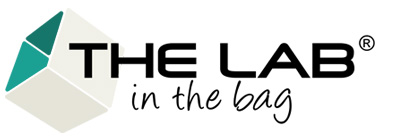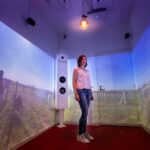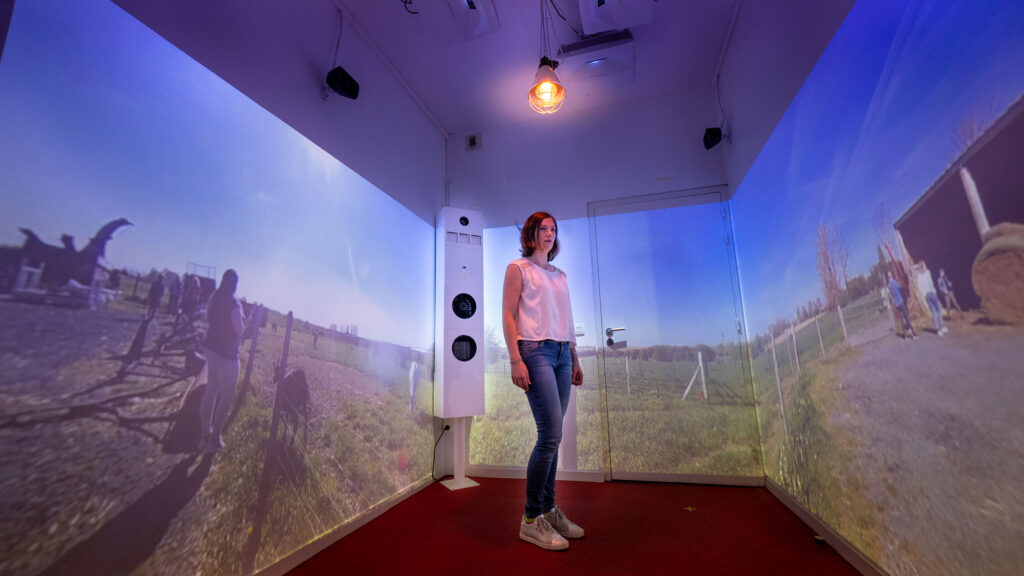

Junia’s feedback on the multisensory immersive room
Mathilde Vandenberghe, lecturer and researcher in sensory evaluation at JUNIA Grande école d’ingénieurs and user of a multisensory immersive room installed by The Lab in the Bag, answers our questions :
1. What were the main factors or needs that led your organisation to invest in a multisensory immersive room ?
Our research team is working on the influence of context on consumer behaviour in relation to food. We know that the context in which we find ourselves influences the way we eat : we eat different quantities and enjoy dishes differently depending on our close environment. Lighting, ambient temperature, sound volume, sound type, smells or even the people with whom we share the moment are parameters that have an impact on our eating behaviour.
We therefore wanted to invest in an immersive room so that we could play with the contexts while controlling the environmental variables. This way, the participants in our studies can travel from one environment to another without leaving the laboratory, but they find themselves in a more ecological environment than standard sensory evaluation laboratories.
We also offer a range of services : Before we had the immersive room, we only offered tests in sensory evaluation laboratories or at home. We wanted to invest in the immersive room so that we could offer our customers something in between. Let’s say a company wants to study the seasonality of its product – which product is most appreciated in a given context – or to determine which context is the best for its product. Studies in the immersive room can respond to these issues and guide companies in their strategy and product development.
2. How does the immersive room fit into your organisation’s overall strategy in terms of technology and innovation? How does the immersive room fit into your product or service creation and development process ?
The immersive room is an integral part of our overall strategy. Our aim is to incorporate more and more technologies and innovations into our research and services. We also aim to be as non-intrusive as possible, so that participants can enjoy an experience without feeling like they’re in a laboratory, surrounded by experimenters.
The immersive room allows us to organise experiments remotely, to use connected devices or even to couple a questionnaire with physiological sensors; this helps us to investigate the user experience from a new angle, in addition to the responses obtained using questionnaires.
3. Can you briefly describe your experience with the immersive room and how it is incorporated into your daily work ?
When we set up a study that requires the use of the immersive room, we think about the protocol and try to obtain all the elements for the most immersive user experience possible. Then we work on a scenario, calibrating the sounds, smells and all the other contextual elements on the 360° video. The immersive room is now an integral part of the sensory laboratory.
4. What types of projects or tasks do you find particularly suited to the immersive room compared with other methods ?
The immersive room is particularly well-suited to putting a food consumption situation into context. Other immersive devices require equipment such as virtual reality headsets. However, when consumers wear this type of device, they can no longer see what they have on their plate, what they have already eaten, nor do they have any reference points for putting the food in their mouths. Moreover, the device physically hampers food intake : to drink the content of a glass, for example, the virtual reality headset is unsuitable because it prevents the glass from being moved widely enough for the liquid to reach the mouth.
When consumers are immersed in the immersive room, they see the food to be tested in front of them and can taste it naturally.
5. What advantages have you seen in using the immersive room compared with other methods ?
The immersive room is less intrusive than other devices such as virtual reality headsets. Study participants don’t have to wear anything. Not wearing an immersive device also solves the problem of cyberkinetosis (virtual motion sickness).
Furthermore, the immersive room allows you to control contextual elements in real time. Effects can be programmed or activated manually during the experience. Experimenters can therefore control the experiments and adapt them according to consumer reactions, for example.
Lastly, the immersive room is equipped with a system of connected objects : this enables a contextual element or scenario to be activated or stopped by placing a given object on a box. Like so, participants are involved in their experience and different scenarios can emerge depending on the objects they choose.
6. How does the immersive room improve research or services within your team or with other departments ?
The immersive room opens up new perspectives for us, and allows us to carry out studies that we didn’t have access to before. Whether these studies are complementary to or separate from the traditional sensory evaluation laboratory, having an immersive room in our laboratory is a real added value.
7. Did you encounter any challenges when using the immersive room, and if so, how did you overcome them ?
The immersive room is a new device, and few people have heard of it or had the opportunity to work with it. While our customers, external stakeholders and employees quickly understand what the immersive room can be used for during demonstrations, it’s not always easy to see how they will actually use it. To overcome this challenge, we strive to find examples that apply to everyone’s activity, so that they can project themselves and imagine working together.
8. How has the immersive room influenced the way you make decisions or solve problems in your field ?
We sometimes wonder whether an effect observed in the sensory evaluation laboratory is due to the standard environment or whether the results would have been the same in real life. Having the immersive room allows us to answer this question and validate or invalidate the results by setting up an appropriate scenario.
9. Can you share specific examples of situations where the immersive room played a key role in the success of a project or initiative? Can you share experiences where the use of the immersive room led to unexpected results, positive or negative, and how did you react in these situations ?
One example of a project we were able to carry out in the immersive room was a study about the effect of a pleasant or unpleasant situation on the perception of a drink.
We immersed participants at the beach or in a noisy construction work zone, where they could taste a non-alcoholic cocktail. Our hypothesis was that the appreciation of the cocktail would be lower in the unpleasant situation than in the pleasant one. The results were not as expected: There was little effect of the context on the appreciation of the cocktail. We concluded that the unpleasant situation was not sufficiently unpleasant and that certain parameters should have been better targeted.
This study enabled us to realise that conducting tests in the immersive room requires pre-testing and relatively lengthy fine-tuning. More generally, each project carried out in the immersive room allows us to refine our protocols and better choose the parameters to achieve the desired immersion.
10. How have customers or external stakeholders reacted to the use of the immersive room in presentations or demonstrations ?
For the demonstrations, we have set up a scenario to showcase all the capabilities offered by the immersive room. When we present the immersive room, customers and external stakeholders have a very positive impression. They understand the value of the room for both research and business applications, and some of them are looking forward to the future.
11. Are there any specific features of the immersive room that you find particularly useful or innovative ?
Being able to provide contextual elements in real time is a real added value to the system. It allows the experimenter to control the immersion while adapting the effects according to the reaction of the participants and the way in which the experimenter feels they are immersed in the context.
As well as the features, we particularly appreciate the customer service and the responsiveness with which we get answers to our questions. On several occasions we’ve had a specific need, such as a feature in the application, for example, and the team at The Lab in the Bag has done everything possible to respond quickly to our needs.
12. How do you measure the effectiveness of using the immersive room in your activities ?
To ensure that participants are immersed in the desired context, we ask them a number of questions at the end of the experience. These include questions to assess their degree of immersion.
Linkedin : Mathilde Vandenberghe


